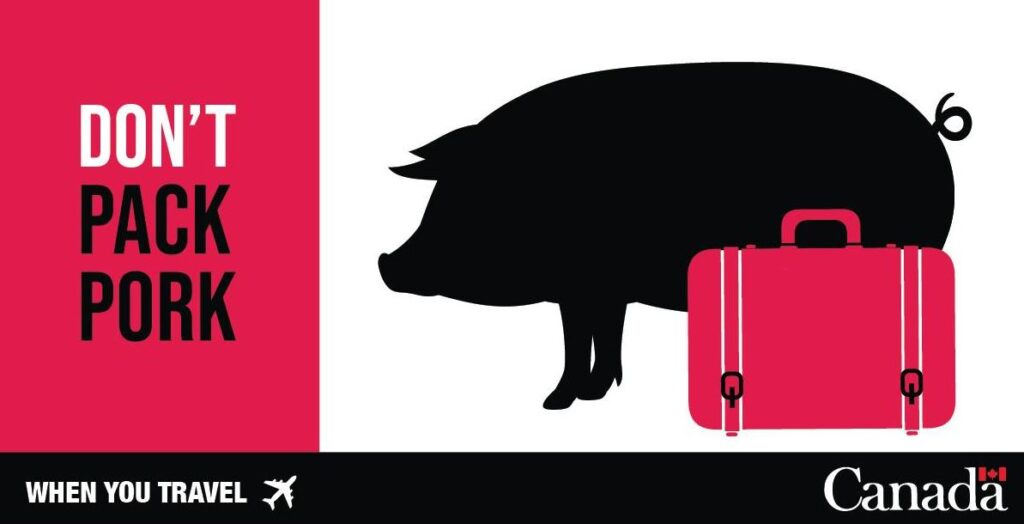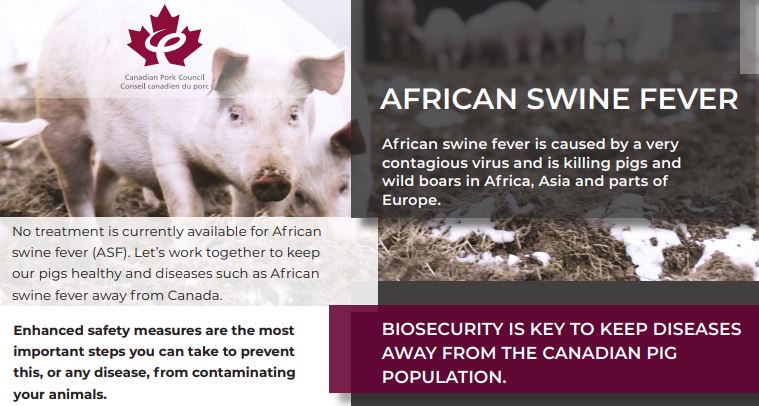By Treena Hein

As all those in the Canadian pork sector know very well, African Swine Fever (ASF) is not found in Canada – nor anywhere in North or South America for that matter – and a huge amount of activity is occurring to keep it that way. This serious pig disease, endemic to Africa, is already found in many locations so far in the Asia-Pacific region, the Caucasus region, eastern Europe and Russia. It was present in wild boar in Belgium until April 2020, and it was first discovered in wild boar in Germany in September 2020.
In April 2019, the Canadian Food Inspection Agency (CFIA) hosted a seminal international forum on ASF entry prevention, and ever since, CFIA, Canada Border Services Agency (CBSA), Swine Innovation Porc (SIP), the Canadian Pork Council (CPC), Canada Pork, provincial agencies and governments and other stakeholders have been working hard on various prevention initiatives.
Canada’s Chief Veterinary Officer, Dr. Jaspinder Komal, explained that, after the forum, a risk assessment was conducted. The biggest potential ASF entry threats were found to be meat products brought into Canada by individual airline travellers, illegal imported shipments of pork from infected countries, imported feed ingredients (especially illegal ones) and insufficient on-farm biosecurity protocols.
“It’s important that people realize that not only can the virus travel in meat products or feed ingredients, but it can survive on clothes and shoes,” said Komal. “This makes it very important that no international visitor who has recently visited a farm in another country visits a farm for two weeks after they arrive back in Canada.”
CFIA is working with CBSA and the travel industry both here and around the world to reach air travellers in a variety of ways about ASF entry prevention (the ‘Don’t Pack Pork’ campaign) and the importance of declaring all food, plant and animal items. These include signage that is seen on airport screens and airlines providing in-flight announcements to passengers upon landing in Canada. CFIA and CBSA have also placed posters at 18 Canadian airports in 16 languages and asked international airlines to post them as well. CBSA provides an ASF pamphlet to travellers who indicate that they have recently visited a farm.
“We also had a very focused campaign for the winter holiday season, from December 2019 to February 2020, and it worked very well,” Komal added.

Online outreach through the CBSA and CFIA websites, along with social media, is ongoing. Relevant ASF operational updates are communicated internally to appropriate staff both in Canada and overseas at airport authorities and airlines. Federal funding provided in 2019 is also enabling CBSA to implement 24 more ‘Detector Dog Service’ teams, which will bring the total to 39 teams focused on agricultural imports by 2024.
Other governments of ASF-free countries are doing similar things. In December 2019, for example, the Australian government announced $66.6 million in funding for more biosecurity officers, six new detector dog teams, new scanning equipment, development of mobile technology to issue infringement fines on the spot and more.
With all this in place, it would have been easy to see if the message was getting through to airline passengers, but the emergence of COVID-19 resulted in the severe curtailment of international travel. However, CBSA notes, from January to August this year, 285 travellers entering Canada failed to declare pork products. Of those, 197 received a $1,300 penalty. Meanwhile, there were no reported cases of product importers who failed to follow the proper protocols. In all of 2019, almost 600 travellers failed to declare pork products (506 received a $1,300 penalty) and another 167 failed to properly import pork products (132 received a $800 penalty).
An ounce of prevention is worth a pound of cure
A Standing Group of Experts on ASF was formed in 2019 to help ensure collaboration, coordination and capacity in the region to prevent the entry of ASF. Komal chairs the group and says that its formation was a key recommendation from the ASF Forum hosted in Canada in April 2019. The standing group helps to ensure key areas for action are advanced, as defined in the framework developed during the forum. Komal also holds multiple ASF-relevant positions at the World Organisation for Animal Health (OIE) and is president of the Regional Steering Committee for the Global Framework for Transboundary Animal Diseases.
Here in Canada, there is the ASF Executive Management Board, a collaboration formed last year between government and industry. It spearheads the pan-Canadian Action Plan on ASF and has allowed, said Komal, “us in the government to work closely with industry members to make collective decisions. We meet every two weeks to continue developing and implementing the Action Plan. This includes preparing frontline workers to do testing for ASF if it appears a pig has the disease. At the CFIA lab in Winnipeg, we are working in collaboration with scientists in Vietnam and with funding from the Swine Health Information Centre in the U.S. to develop a non-invasive rapid diagnostic tool involving saliva.”
So far in the development of this tool, testing of saliva taken from a rope hung in a pen with ASF-positive pigs has provided good accuracy, but evaluation needs to be done in commercial conditions to see if this accuracy holds. The work on the pen-side test kit, Komal explained, has involved things like ensuring reagents would store at ambient temperatures. There is now an agreement with a company to mass-produce the kit, and they are expected to be ready sometime in 2021.

To improve Canada’s ability to detect ASF should it enter our borders, a program called ‘CanSpotASF’ has been launched to enhance surveillance activities. Risk-based early detection testing at approved laboratories is the first new surveillance tool to be implemented as part of CanSpotASF.
Development of rapid ASF testing is also part of SIP’s current research priorities, announced in May 2020. After the 2019 forum, SIP had invited various Canadian and U.S. swine health experts to form the Coordinated ASF Research Working Group, which includes Dr. Egan Brockhoff, a swine veterinarian in Alberta who is also the CPC’s veterinary lead. Other working group research priorities include biosecurity (including control of wild pigs, which could potentially spread the disease over large areas of Canada), and in the event of an outbreak, the destruction and disposal of infected pigs and the ensuing economic impact and recovery phase.
Brockhoff noted that there is no evidence to suggest ASF is present in Canada’s wild pig population, but a working group that is developing ASF surveillance options for Canada may include wild pigs.
The CFIA has also formed the ASF National Emergency Operations Centre, which can create scalable regional command structures and holds national simulation exercises to ensure that the response to an ASF outbreak in Canada would be smoothly coordinated. Some of these simulations are done in partnership with U.S. authorities.
“We recently went over roles and responsibilities in terms of who makes what decisions,” said Komal. “And we are planning a simulation involving movement of pigs.”
Vaccines and antivirals for ASF are also being tested and developed, as announced in January 2020, at the University of Saskatchewan’s Vaccine and Infectious Disease Organization-International Vaccine Centre (VIDO-InterVac).
ASF brings major trade implications
On the export front, Canada has re-confirmed established reciprocal ‘zoning arrangements’ for trade of pork with the U.S. and the European Union. This means that, should there be an ASF outbreak in Canada, export of pork can continue from non-infected zones once zones are established in Canada and the importing countries accept the zoning decisions made by Canada. Trade zone arrangements are also being sought with Japan and some other Asian countries.
Brockhoff explains that, in addition, ‘compartmentalization’ guidelines are being worked out by the OIE, and various countries, including Canada, are working on the development of compartment standards.
“It’s management-focused and not geography-focused,” Brockhoff explained. “That is, a group of vertically integrated producers working under the same biosecurity, traceability and surveillance management system would still be able to export pork even though their ‘compartment’ is located within an ASF-infected geographical zone.”
Komal noted, however, that if the international guidelines for this concept that are currently being developed are not accepted by trading partners, the pork from a compartment within an infected zone in Canada could only be consumed domestically.
“I think we’re getting there with the U.S. and Europe at least,” Komal said. “But zoning is the primary tool to ensure trade continues.”
Producers should pay attention to feed risks

It was back in early 2014, when porcine epidemic diarrhea (PED) first arrived in Canada, that it was determined the virus that causes the disease had been transmitted through imported feed. Studies were later done in the U.S. on many other pathogens, including ASF, and it was confirmed that the ASF can easily be transmitted through feed. In response, the CPC has listed pig feed ingredients according to risk of ASF and provided feed storage time and temperature recommendations for producers. Komal has recommended that producers should look for feed made at mills that belong to the FeedAssure Program. By April 2019, CFIA had placed additional import controls on plant-based feed ingredients from countries of ASF transmission concern.
A big development on the feed front came this year in July, when U.S. scientists published results showing that 14 commercial feed additives can mitigate the presence of Senecavirus A, PED and Porcine Reproductive and Respiratory Syndrome (PRRS) in contaminated feed. The products include essential oils, organic acids, fatty acid blends and formaldehyde-based products. Pigs on supplemented diets had significantly greater average daily gain, significantly lower clinical signs and infection levels, and numerically lower mortality rates compared to non‐supplemented controls. Tests of these products on mitigating ASF are being conducted now.
ASF prevention going forward
Looking ahead at the future of ASF prevention in Canada, Komal, Brockhoff and many others believe the unprecedented measures to keep Canada ASF-free must continue.
“Given the seriousness of this disease, I think it will remain in the forefront of transboundary animal disease prevention efforts,” said Komal.





